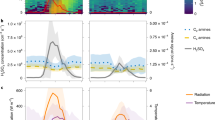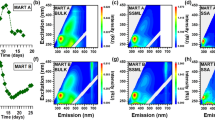Abstract
Marine aerosol contributes significantly to the global aerosol load and consequently has an important impact on both the Earth's albedo and climate. So far, much of the focus on marine aerosol has centred on the production of aerosol from sea-salt1 and non-sea-salt sulphates2,3. Recent field experiments, however, have shown that known aerosol production processes for inorganic species cannot account for the entire aerosol mass that occurs in submicrometre sizes4,5,6. Several experimental studies have pointed to the presence of significant concentrations of organic matter in marine aerosol7,8,9,10,11. There is some information available about the composition of organic matter12,13,14, but the contribution of organic matter to marine aerosol, as a function of aerosol size, as well as its characterization as hydrophilic or hydrophobic, has been lacking. Here we measure the physical and chemical characteristics of submicrometre marine aerosol over the North Atlantic Ocean during plankton blooms progressing from spring through to autumn. We find that during bloom periods, the organic fraction dominates and contributes 63% to the submicrometre aerosol mass (about 45% is water-insoluble and about 18% water-soluble). In winter, when biological activity is at its lowest, the organic fraction decreases to 15%. Our model simulations indicate that organic matter can enhance the cloud droplet concentration by 15% to more than 100% and is therefore an important component of the aerosol–cloud–climate feedback system involving marine biota.
This is a preview of subscription content, access via your institution
Access options
Subscribe to this journal
Receive 51 print issues and online access
$199.00 per year
only $3.90 per issue
Buy this article
- Purchase on Springer Link
- Instant access to full article PDF
Prices may be subject to local taxes which are calculated during checkout




Similar content being viewed by others
References
O'Dowd, C. D., Lowe, J. A. & Smith, M. H. Marine aerosol, sea-salt, and the marine sulphur cycle: A short review. Atmos. Environ. 31, 73–80 (1997)
Shaw, G. Bio-controlled thermostasis involving the sulfur cycle. Clim. Change 5, 297–303 (1983)
Charlson, R. J., Lovelock, J. E., Andreae, M. O. & Warren, S. G. Oceanic phytoplankton, atmospheric sulfur, cloud albedo and climate. Nature 326, 655–661 (1987)
McInnes, L. M., Quinn, P. K., Covert, D. S. & Anderson, T. L. Gravimetric analysis, ionic composition and associated water mass of the marine aerosol. Atmos. Environ. 30, 869–884 (1996)
Hubert, B. J. et al. Filter and impactor measurements of anions and cations during the First Aerosol Characterization Experiment (ACE 1). J. Geophys. Res. 103, 16493–16509 (1998)
Quinn, P. K. et al. Surface submicron aerosol chemical composition: What fraction is not sulfate? J. Geophys. Res. 105, 6785–6805 (2000)
Hoffman, E. J. & Duce, R. A. The organic carbon content of marine aerosol collected on Bermuda. J. Geophys. Res. 79, 4474–4477 (1976)
Novakov, T. et al. Organic aerosols in the Caribbean trade winds: A natural source? J. Geophys. Res. 102, 21307–21313 (1997)
Middlebrook, A. M., Murphy, D. M. & Thomson, D. Observation of organic material in individual marine particles at Cape Grim during the First Aerosol Characterization Experiment (ACE 1). J. Geophys. Res. 103, 16475–16483 (1998)
Putaud, J.-P. et al. Chemical mass closure and assessment of the origin of the submicron aerosol in the marine boundary layer and the free troposphere at Tenerife during ACE-2. Tellus 52B, 141–168 (2000)
Kleefeld, S., Hoffer, A., Krivacsy, Z. & Jennings, S. G. Importance of organic and black carbon in atmospheric aerosols at Mace Head, on the West Coast of Ireland. Atmos. Environ. 36, 4479–4490 (2002)
Kawamura, K. & Gagosian, R. B. Mid-chain ketocarboxylic acids in the remote marine atmosphere: Distribution patterns and possible formation mechanisms. J. Atmos. Chem 11, 107–122 (1990)
Gagosian, R. B., Peltzerand, E. T. & Zafirou, O. C. Atmospheric transport of continentally derived lipids to the tropical North Pacific. Nature 291, 312–315 (1981)
Gogou, A. I., Aposolaki, M. & Stephanou, E. G. Determination of organic molecular markers in marine aerosols and sediments: one-step flash chromatography compound class fractionation and capillary gas chromatographic analysis. J. Chromatogr. A 799, 215–231 (1998)
Cavalli, F. et al. Advances in identification of organic matter in marine aerosol. J. Geophys. Res. 109, doi: 10.1029/2004JD0051377 (2004)
Gershey, R. M. Characterization of seawater organic matter carried by bubble-generated aerosols. Limnol. Oceanogr. 28, 309–319 (1983)
Mochida, M., Kitamori, Y., Kawamura, K., Nojiri, Y. & Suzuki, K. Fatty acids in the marine atmosphere: Factors governing their concentrations and evaluation of organic films on sea salt particles. J. Geophys. Res. 107, doi:10.1029/2001JD001278 (2002)
Oppo, C. et al. Surfactant component of marine organic matter as agents for biogeochemical fractionation of pollutants transport via marine aerosol. Mar. Chem. 63, 235–253 (1999)
Blanchard, D. C. Bubble scavenging and the water to air transfer of organic material in the sea. Adv. Chem. Ser. 145, 360–387 (1976)
Geever, M. et al. Measurements of primary marine aerosol fluxes at Mace Head, Ireland. In Abstracts of European Aerosol Conference, Madrid, 2003, Vol. 1 J. Aer. Sci. S637–S638 (2003).
Martensson, E. M., Nilsson, E. D., de Leeuw, G., Cohen, L. H. & Hansson, H. C. Laboratory simulations and parameterization of the primary marine aerosol production. J. Geophys. Res. 108, doi:10.1029/2002JD002263 (2003)
Facchini, M. C., Mircea, M., Fuzzi, S. & Charlson, R. J. Cloud albedo enhancement by surface-active organic solutes in growing droplets. Nature 401, 257–259 (1999)
Nenes, A. et al. Can chemical effects on cloud droplet number rival the first indirect effect? Geophys. Res. Lett. 29, doi: 10.1029/2002GL015295 (2002)
Beardall, J. & Raven, J. A. The potential effects of global climate change on microalgal photosynthesis, growth and ecology. Phycologia 43, 26–40 (2004)
Acknowledgements
This work was partly supported by the European Commission (Projects QUEST and PHOENICS), Irish Research Council for Science, Engineering and Technology, and the Irish Higher Education Authority, Italian Ministry of Environment (Italy–USA Cooperation on Science and Technology of Climate Change). SeaWiFS chlorophyll products were provided by the SeaWiFS project, NASA/Goddard Space Flight Center and ORBIMAGE.
Author information
Authors and Affiliations
Corresponding author
Ethics declarations
Competing interests
The authors declare that they have no competing financial interests.
Supplementary information
Supplementary Information
Potential contribution of coastal sources to aerosol properties at Mace Head. (DOC 295 kb)
Rights and permissions
About this article
Cite this article
O'Dowd, C., Facchini, M., Cavalli, F. et al. Biogenically driven organic contribution to marine aerosol. Nature 431, 676–680 (2004). https://doi.org/10.1038/nature02959
Received:
Accepted:
Issue Date:
DOI: https://doi.org/10.1038/nature02959
This article is cited by
-
Ice nucleation catalyzed by the photosynthesis enzyme RuBisCO and other abundant biomolecules
Communications Earth & Environment (2023)
-
Sea spray as an obscured source for marine cloud nuclei
Nature Geoscience (2022)
-
Factors controlling the transfer of biogenic organic species from seawater to sea spray aerosol
Scientific Reports (2022)
-
Real-time single particle characterization of oxidized organic aerosols in the East China Sea
npj Climate and Atmospheric Science (2022)
-
The role of sea spray in atmosphere–ocean gas exchange
Nature Geoscience (2021)
Comments
By submitting a comment you agree to abide by our Terms and Community Guidelines. If you find something abusive or that does not comply with our terms or guidelines please flag it as inappropriate.



